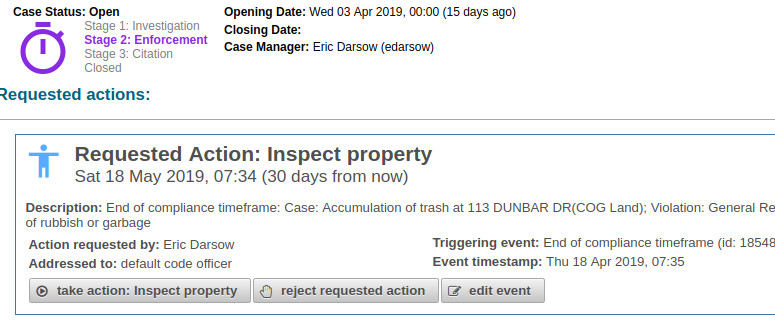Subsystem briefing: Code enforcement phase management and requested events
This overview page describes how COGConnect represents and processes Code Enforcement case events and their associated phase changes. The representative screen shot of the UI for these services is found in ceCases.xhtml and looks like this (extra UI elements clipped):

CasePhase and case stages
Code enforcement cases possess a CasePhase object which is a custom type in postgres and an Enum in Java. In the early days of COGConnect these phases were vetted and checked with code officers. Jesse even said “That’s exactly what we do.” The challenge is, however, that a seven-phase work flow is not easily tracked in one’s head. We needed a more succinct way to express where a given code enforcement case may be in its life cycle.
CitationStatus objects also contain a CasePhaseChangeRule object which is processed whenever a Citation changes status. This, processing may lead to a change in CasePhase but also the creation of additional Event objects.
The CasePhase progression
The Phases are as follows (in order of actual case management workflow)
- PrelimInvestigationPending(“Preliminary Investigation Pending”),
- NoticeDelivery(“Notice of Violation Delivery”),
- InitialComplianceTimeframe(“Initial Compliance Timeframe”),
- SecondaryComplianceTimeframe(“Secondary Compliance Timeframe”),
- AwaitingHearingDate(“Awaiting Hearing”),
- HearingPreparation(“Hearing Preparation”),
- InitialPostHearingComplianceTimeframe(“Initial Post-Hearing Compliance Timeframe”),
- SecondaryPostHearingComplianceTimeframe(“Secondary Post-Hearing Compliance Timeframe”),
- InactiveHolding(“Inactive Holding”),
- Closed(“Closed”),
- LegacyImported(“Legacy data container case”);
Case stages
A case stage (not a Java object) is a value derived from the case’s phase, and reduces the seven phases to three active stages and the closed stage:
- Investigation (A notice of violation has not yet been mailed)
- Enforcement (Notice has been mailed, and no violations have been cited)
- Citation (At least one code violation on the case has been attached to a citation)
Bundling of logic in CasePhaseChangeRule objects
Ushering a code enforcement case through these phases is driven by a set of rules which are encapsulated in an object called the CasePhaseChangeRule. These objects live on EventCategory objects and, when present on a given Event, are used by the CaseCoordinator during event processing to make two distinct but related determinations:
- Should this case’s phase be changed? If so, to what?
- Do I need to create an Event that requests an action from a user? If so, what
EventCategoryshould be requested?
Information for making both of these determinations is bundled in the single CasePhaseChangeRule object because many requested event categories themselves trigger case phase changes, so designing the relationships together and writing them to a single object simplifies what is already a somewhat convoluted determination process.
Chained triggers
If a CasePhase rule passes, that rule’s specified triggered EventCategory is created and added to the case. Since this EventCategory could also have its own rule, and triggered EventCategory, a set cascade of case changes may occur with the processing of a single event.
For example, if a Citation has its status changed to ‘case dismissed’, that CitationStatus object will contain a CasePhaseChangeRule object which specifies that the code enforcement case’s CasePhase should become CasePhase.Closed and that a logically categorized Event should be attached to the case depicting this particular series of events–to be forever encapsulated in the case’s history.